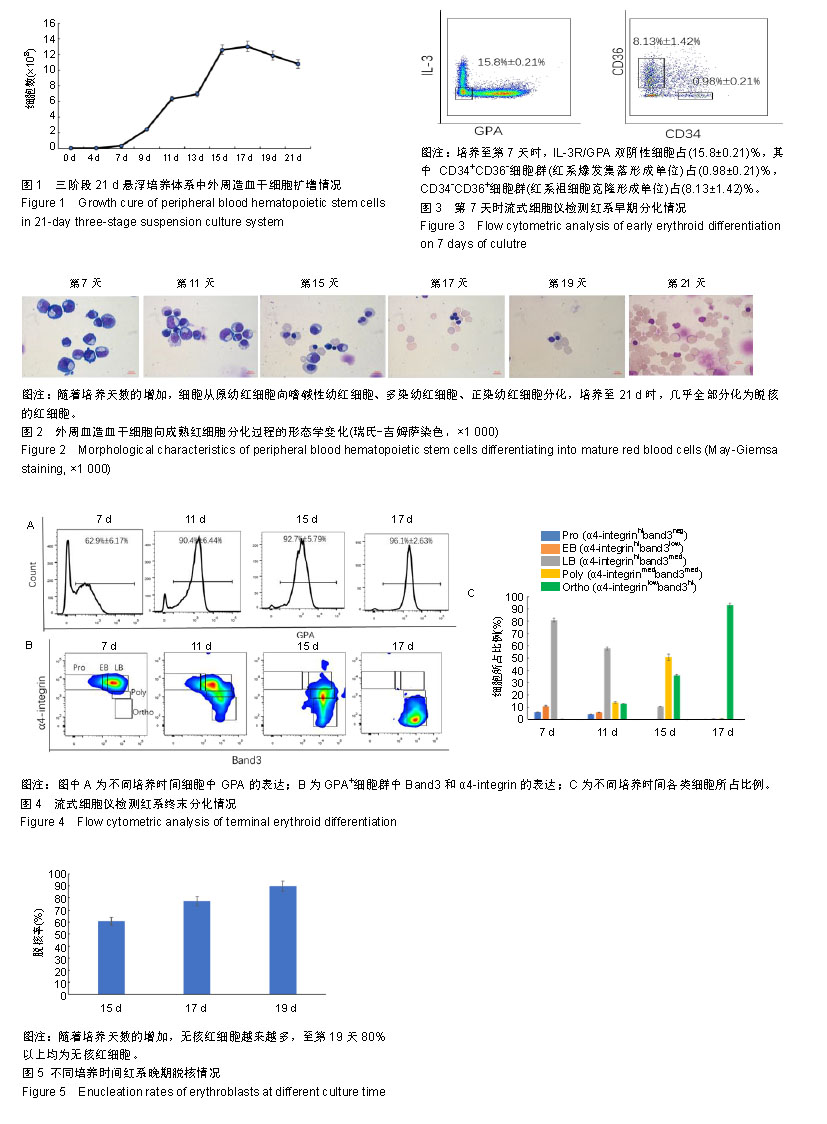| [1]Zeuner A, Martelli F, Vaglio S, et al. Concise review: stem cell-derived erythrocytes as upcoming players in blood transfusion. Stem Cells. 2012;30(8):1587-1596.[2]Ali A, Auvinen MK, Rautonen J. The aging population poses a global challenge for blood services. Transfusion. 2010;50(3): 584-588.[3]Seifried E, Klueter H, Weidmann C, et al. How much blood is needed. Vox Sang. 2011;100(1):10-21.[4]欧阳剑,贝春花,何军,等. 2006-2014年广东省27家血站采供血情况分析[J].中国输血杂志,2016,29(9): 959-961.[5]赵永鲜,杨惠娟,于莹,等.北京市孕产妇抢救用血情况调查[J].中国妇幼保健,2014,29(31):5148-5150.[6]Giarratana MC, Kobari L, Lapillonne H, et al. Ex vivo generation of fully mature human red blood cells from hematopoietic stem cells. Nat Biotechnol. 2005;23(1):69-74.[7]Miharada K, Hiroyama T, Sudo K, et al. Efficient enucleation of erythroblasts differentiated in vitro from hematopoietic stem and progenitor cells. Nat Biotechnol. 2006;24(10):1255-1256.[8]Baek EJ, Kim HS, Kim S, et al. In vitro clinical-grade generation of red blood cells from human umbilical cord blood CD34+ cells. Transfusion. 2008;48(10):2235-2245.[9]贾延军,刘江,张可莹.脐血CD34+细胞体外诱导扩增红系细胞的探索[J].中国实验血液学杂志,2009,17(3):787-792.[10]Zhang Y, Wang C, Wang L, et al. Large-Scale Ex Vivo Generation of Human Red Blood Cells from Cord Blood CD34+ Cells. Stem Cells Transl Med. 2017;6(8):1698-1709.[11]Esposito MT. Hematopoietic stem cells meet induced pluripotent stem cells technology. Haematologica. 2016;101(9):999-1001.[12]Lapillonne H, Kobari L, Mazurier C, et al. Red blood cell generation from human induced pluripotent stem cells: perspectives for transfusion medicine. Haematologica. 2010; 95(10):1651-1659.[13]Palis J. Ontogeny of erythropoiesis. Curr Opin Hematol. 2008; 15(3):155-161.[14]Sipp D. Challenges in the clinical application of induced pluripotent stem cells. Stem Cell Res Ther. 2010;1(1):9. [15]Dias J, Gumenyuk M, Kang H, et al. Generation of red blood cells from human induced pluripotent stem cells. Stem Cells Dev. 2011; 20(9):1639-1647.[16]Kobari L, Yates F, Oudrhiri N, et al. Human induced pluripotent stem cells can reach complete terminal maturation: in vivo and in vitro evidence in the erythropoietic differentiation model. Haematologica. 2012;97(12):1795-1803.[17]Lu SJ, Feng Q, Park JS, et al. Biologic properties and enucleation of red blood cells from human embryonic stem cells. Blood. 2008; 112(12): 4475-4484.[18]Ran D, Shia WJ, Lo MC, et al. RUNX1a enhances hematopoietic lineage commitment from human embryonic stem cells and inducible pluripotent stem cells. Blood. 2013;121(15):2882-2890.[19]贾延军,刘江,张可莹,等.培养条件对CD34+细胞体外诱导分化和扩增红细胞的影响[J].中国输血杂志,2010,23(2):107-110.[20]Batta K, Menegatti S, Garcia-Alegria E, et al. Concise Review: Recent Advances in the In Vitro Derivation of Blood Cell Populations. Stem Cells Transl Med. 2016;5(10):1330-1337.[21]Jin H, Kim HS, Kim S, et al. Erythropoietic potential of CD34+ hematopoietic stem cells from human cord blood and G-CSF- mobilized peripheral blood. Biomed Res Int. 2014;2014: 435215.[22]Migliaccio G, Migliaccio AR. Cloning of human erythroid progenitors (BFU-E) in the absence of fetal bovine serum. Br J Haematol.1987; 67(2):129-133.[23]Fujimi A, Matsunaga T, Kobune M, et al. Ex vivo large-scale generation of human red blood cells from cord blood CD34+ cells by co-culturing with macrophages. Int J Hematol. 2008;87(4): 339-350.[24]Kawano Y, Kobune M, Yamaguchi M, et al. Ex vivo expansion of human umbilical cord hematopoietic progenitor cells using a coculture system with human telomerase catalytic subunit (hTERT)-transfected human stromal cells. Blood. 2003;101(2): 532-540.[25]贾延军,刘江,张可莹,等.利用外周血单个核细胞生产成熟红细胞[J].中国实验血液学杂志,2014,22(5):1435-1441.[26]Hu J, Liu J, Xue F, et al. Isolation and functional characterization of human erythroblasts at distinct stages: implications for understanding of normal and disordered erythropoiesis in vivo. Blood. 2013;121(16):3246-3253.[27]廖基灵,张洁莹,韩旭,等. AB血清对人体外终末期红系分化进程的影响[J].中南大学学报(医学版), 2016,41(12): 1245-1251.[28]Li J, Hale J, Bhagia P, et al. Isolation and transcriptome analyses of human erythroid progenitors: BFU-E and CFU-E. Blood. 2014; 124(24):3636-3645.[29]Ubukawa K, Guo YM, Takahashi M, et al. Enucleation of human erythroblasts involves non-muscle myosin IIB. Blood. 2012;119(4): 1036-1044.[30]Keerthivasan G, Small S, Liu H, et al. Vesicle trafficking plays a novel role in erythroblast enucleation. Blood. 2010;116(17): 3331-3340. |
.jpg)

.jpg)